Rectenna System Development Using Harmonic Balance and S-Parameters for an RF Energy Harvester
Abstract
1. Introduction
- Optimization of cascading 7-stage Cockroft–Walton rectifier design with the implementation of an MA4E2054B1-1146T Schottky diode through harmonic balance simulation and prototype experimentation, forecasting an efficiency increase and, therefore, an improvement in the capability of harvesting DC output at lower power input at 2.4 GHz frequency with 1.5 V benchmark;
- Simulation of S-parameters, along with realization and performance test of fractal antenna design as a viable component in electromagnetic radiation in the form of microwaves into electrical energy conversion;
- Contribution in quantitative analysis of the potential and performance of the energy-harvester prototype with a rectifier and fractal antenna combination in capturing radiation signals from a Wi-Fi source in a real environment.
2. Rectenna Architecture
2.1. Rectifier Topology
2.2. Harmonic Rejection Filters
2.3. Transmission Line Modeling
2.4. Substrate Laminate
2.5. Matching Network
2.6. Fractal Antenna
3. Design and Fabrication
3.1. Schottky Diode Parasitic Model
3.2. Seven-Stage Rectifier and Bessel Low-Pass Filter Design
3.3. Fractal Antenna
3.4. Return Loss S11 (dB) and Voltage Standing-Wave Ratio
3.5. Signal Strength of Fractal Antenna
3.5.1. Direct Input with RF Generator DC Output Measurement
3.5.2. Red LED Indicator Feasibility Test
3.5.3. DC Voltage Measurement of Rectenna System with Wi-Fi Router as RF Source
4. Results and Discussion
4.1. Return Loss Results of the Two Rectifier Prototypes
4.2. Standing-Wave Ratio of Rectifier Prototypes
4.3. S11-Parameters of Fractal Antenna Result
4.4. Voltage Standing-Wave Ratio Measurement in Fractal Antenna
4.5. Result of Signal Strength of Antennas from Wi-Fi Router Power-Source Measurement
4.6. DC Output Measurement of Rectifier with Direct Input Power from RF Generator
4.7. Rectenna System Response with RF Generator
4.8. Rectenna System Performance from Wi-Fi Power Source
4.9. Ambient Voltage Reading
5. Benchmarking
6. Conclusions
Author Contributions
Funding
Institutional Review Board Statement
Informed Consent Statement
Data Availability Statement
Acknowledgments
Conflicts of Interest
References
- Han, X.; Lu, L.; Zheng, Y.; Feng, X.; Li, Z.; Li, J.; Ouyang, M. A review on the key issues of the lithium ion battery degradation among the whole life cycle. ETransportation 2019, 1, 100005. [Google Scholar] [CrossRef]
- Das, R.; Chang, Y.H.; Dyson, M. RFID Forecasts, Players and Opportunities 2022–2032; RFID Report; IDTechEx: Cambridge, UK, 2023. [Google Scholar]
- Selim, K.K.; Wu, S.; Saleeb, D.A. An optimized rectifier design for rf energy harvesting at the 2.45 ghz wifi frequency band. In Proceedings of the 2020 27th International Conference on Telecommunications (ICT), Bali, Indonesia, 5–7 October 2020; IEEE: Piscataway, NJ, USA, 2020; pp. 1–5. [Google Scholar]
- Mathur, M.; Agarwal, A.; Singh, G.; Bhatnagar, S.K. A Novel Design Module of RF Energy Harvesting for Powering the Low Power Electronics Circuits. In Proceedings of the International Conference on Advances in Information Communication Technology and Computing, Jaipur, India, 21–24 September 2016; pp. 1–4. [Google Scholar]
- Diagarajan, M.; Ramasamy, A.K.; Din, N.M. Advanced Radio Frequency Energy Harvesting with Power Management from Multiple Sources for Low Power Sensors and Mobile Charging Applications. Prog. Electromagn. Res. 2020, 89, 45–62. [Google Scholar] [CrossRef]
- Adam, I.; Yasin, M.N.M.; Ibrahim, S.Z.; Haris, N. Development of cascaded voltage doubler rectifier for rf energy harvesting. J. Teknol. 2022, 84, 153–161. [Google Scholar] [CrossRef]
- Ipar, P.E.; Lambor, S.M.; Joshi, S.M. Development of radio frequency energy harvesting module. In Proceedings of the 2016 IEEE Annual India Conference (INDICON), Bangalore, India, 16–18 December 2016; IEEE: Piscataway, NJ, USA, 2016; pp. 1–6. [Google Scholar]
- Bougas, I.D.; Papadopoulou, M.S.; Boursianis, A.D.; Kokkinidis, K.; Goudos, S.K. State-of-the-art techniques in RF energy harvesting circuits. Telecom 2021, 2, 369–389. [Google Scholar] [CrossRef]
- Hong, S.S.B.; Ibrahim, R.B.; Khir, M.H.M.; Zakariya, M.A.B.; Daud, H. WI-FI energy harvester for low power RFID application. Prog. Electromagn. Res. 2013, 40, 69–81. [Google Scholar] [CrossRef]
- Kobougias, I.C.; Tatakis, E.C. Optimal design of a Half Wave Cockroft-Walton Voltage Multiplier with different capacitances per stage. In Proceedings of the 2008 13th International Power Electronics and Motion Control Conference, Poznan, Poland, 1–3 September 2008; IEEE: Piscataway, NJ, USA, 2008; pp. 1274–1279. [Google Scholar]
- Curty, J.-P.; Declercq, M.; Dehollain, C.; Joehl, N. Design and Optimization of Passive UHF RFID Systems; Springer: New York, NY, USA, 2007; Volume 323. [Google Scholar]
- Merabet, B.; Cirio, L.; Takhedmit, H.; Costa, F.; Vollaire, C.; Allard, B.; Picon, O. Low-cost converter for harvesting of microwave electromagnetic energy. In Proceedings of the 2009 IEEE Energy Conversion Congress and Exposition, San Jose, CA, USA, 20–24 September 2009; IEEE: Piscataway, NJ, USA, 2009; pp. 2592–2599. [Google Scholar]
- Hong, S.S.B.; Ibrahim, R.; Khir, M.H.M.; Daud, H.; Zakariya, M.A. Rectenna architecture based energy harvester for low power RFID application. In Proceedings of the 2012 4th International Conference on Intelligent and Advanced Systems (ICIAS2012), Kuala Lumpur, Malaysia, 12–14 June 2012; IEEE: Piscataway, NJ, USA, 2012; Volume 1, pp. 382–387. [Google Scholar]
- Yeoh, W. Wireless power Transmission (WPT) Application at 2.4 GHz in Common Network. Ph.D. Dissertation, RMIT University, Melbourne, Australia, 2010. [Google Scholar]
- Chen, R.H.; Lee, Y.C.; Sun, J.S. Design and experiment of a loop rectenna for RFID wireless power transmission and data communication applications. Piers Proc. 2009, 528, 23–27. [Google Scholar]
- Salleh, S.; Zakariya, M.A.; Lee, R.M.A. A comparison study of rectifier designs for 2.45 GHz EM energy harvesting. Energy Power Eng. 2021, 13, 81–89. [Google Scholar] [CrossRef]
- Arrigo, J. Input and Output Capacitor Selection. 2006. Available online: http://www.ti.com/lit/an/slta055/slta055.pdf (accessed on 30 December 2006).
- Neamen, D.A. Electronic Circuit Analysis and Design; McGraw-Hill: New York, NY, USA, 2001; Volume 2. [Google Scholar]
- Harrist, D.W. Wireless Battery Charging System Using Radio Frequency Energy Harvesting. Ph.D. Dissertation, University of Pittsburgh, Pittsburgh, PA, USA, 2004. [Google Scholar]
- Fritzin, J.; Svensson, C.; Alvandpour, A. Design and analysis of a class-D stage with harmonic suppression. IEEE Trans. Circuits Syst. Regul. Pap. 2011, 59, 1178–1186. [Google Scholar] [CrossRef]
- Witte, R.A. Electronic Test Instruments: Analog & Digital Measurements; Prentice-Hall: Englewood Cliffs, NJ, USA, 2002; Chapter 1; p. 31. [Google Scholar]
- Kim, Y.-H.; Lim, S.-J. A highly efficient rectenna using harmonic rejection capability. J. Korean Inst. Electromagn. Sci. 2011, 11, 257–261. [Google Scholar] [CrossRef]
- Bianchi, G.; Sorrentino, R. Electronic Filter Simulation and Design; McGraw-HillProfessional: Chicago, IL, USA, 2007; ISBN 9780071494670. [Google Scholar]
- Simberian Inc. Effect of Microstrip Line Width on Losses per Unit Length. 2007. Available online: http://www.simberian.com/AppNotes/LossesInMicrostripLine_2007_06.pdf (accessed on 30 December 2007).
- AgilentTechnologies. ADS 2008: Distributedcomponents. Available online: https://edadownload.software.keysight.com/eedl/ads/201101/pdf/ccdist.pdf (accessed on 30 December 2007).
- Mitzner, K. Complete PCB Design Using OrCAD Capture and PCB Editor; Academic Press: Newnes, Australia, 2009. [Google Scholar]
- Rouphael, T.J. Wireless Receiver Architectures and Design: Antennas, RF, Synthesizers, Mixed Signal, and Digital Signal Processing; Academic Press: Cambridge, MA, USA, 2014. [Google Scholar]
- Jamil, A.; Yusoff, M.Z.; Yahya, N. Analysis of a hybrid fractal curve antenna using the segmentation method. Eng. Rep. 2020, 2, e12263. [Google Scholar] [CrossRef]
- Kikkert, C.J. RF Electronic: Design and Simulation. Available online: https://resources.system-analysis.cadence.com/i/1325428-rf-electronics-design-and-simulation/0 (accessed on 30 December 2007).
- Intanavongsa, P.; Muncuk, U.; Lewis, D.R.; Chowdhury, K.R. Design optimization and implementation for RF energy harvesting circuits. IEEE J. Emerg. Sel. Top. Circuits Syst. 2012, 2, 24–33. [Google Scholar] [CrossRef]
- Liu, L.; Mu, J.; Ma, N.; Zhu, Z. A hybrid threshold self-compensation rectifier for RF energy harvesting. IEICE Electron. Express 2014, 11, 20141000. [Google Scholar] [CrossRef]
- Block, A.A. Affine transformation. J. Inst. Telev. Eng. Jpn. 1974, 28, 251–256. [Google Scholar]
- Yang, L. The Measurement of Antenna VSWR by Means of a Vector Network Analyzer. 2020. Available online: https://www.diva-portal.org/smash/get/diva2:1472786/FULLTEXT01.pdf (accessed on 30 December 2007).
- Kurokawa, K. Power waves and the scattering matrix. IEEE Trans. Microw. Theory Tech. 1965, 13, 194–202. [Google Scholar] [CrossRef]
- Muslu, A.M.; Ozluk, B.; Tamdogan, E.; Arik, M. Impact of junction temperature over forward voltage drop for red, blue and green high power light emitting diode chips. In Proceedings of the 2017 16th IEEE Intersociety Conference on Thermal and Thermomechanical Phenomena in Electronic Systems (ITherm), Orlando, FL, USA, 30 May–2 June 2017; IEEE: Piscataway, NJ, USA, 2017; pp. 1011–1019. [Google Scholar]
- Ibrahim, R.B.; Mohd, S.H.S.B.; Haris, B.; Zakariya, M.A.B.; Daud, H. Powering LED from Wi-Fi: A qualitative assessment for rectenna design. In Proceedings of the 2014 15th International Conference on Sciences and Techniques of Automatic Control and Computer Engineering (STA), Hammamet, Tunisia, 21–23 December 2014; IEEE: Piscataway, NJ, USA, 2014; pp. 793–796. [Google Scholar]
- Ibrahim, R.; Jamil, A.; Yusoff, M.Z. Design and analysis of an RF rectifying circuit upon integration with monopole and Fractal antennas. In Proceedings of the 2nd IEEE International Symposium on Robotics and Manufacturing Automation (ROMA), Ipoh, Malaysia, 25–27 September 2016; IEEE: Piscataway, NJ, USA, 2016; pp. 1–5. [Google Scholar]

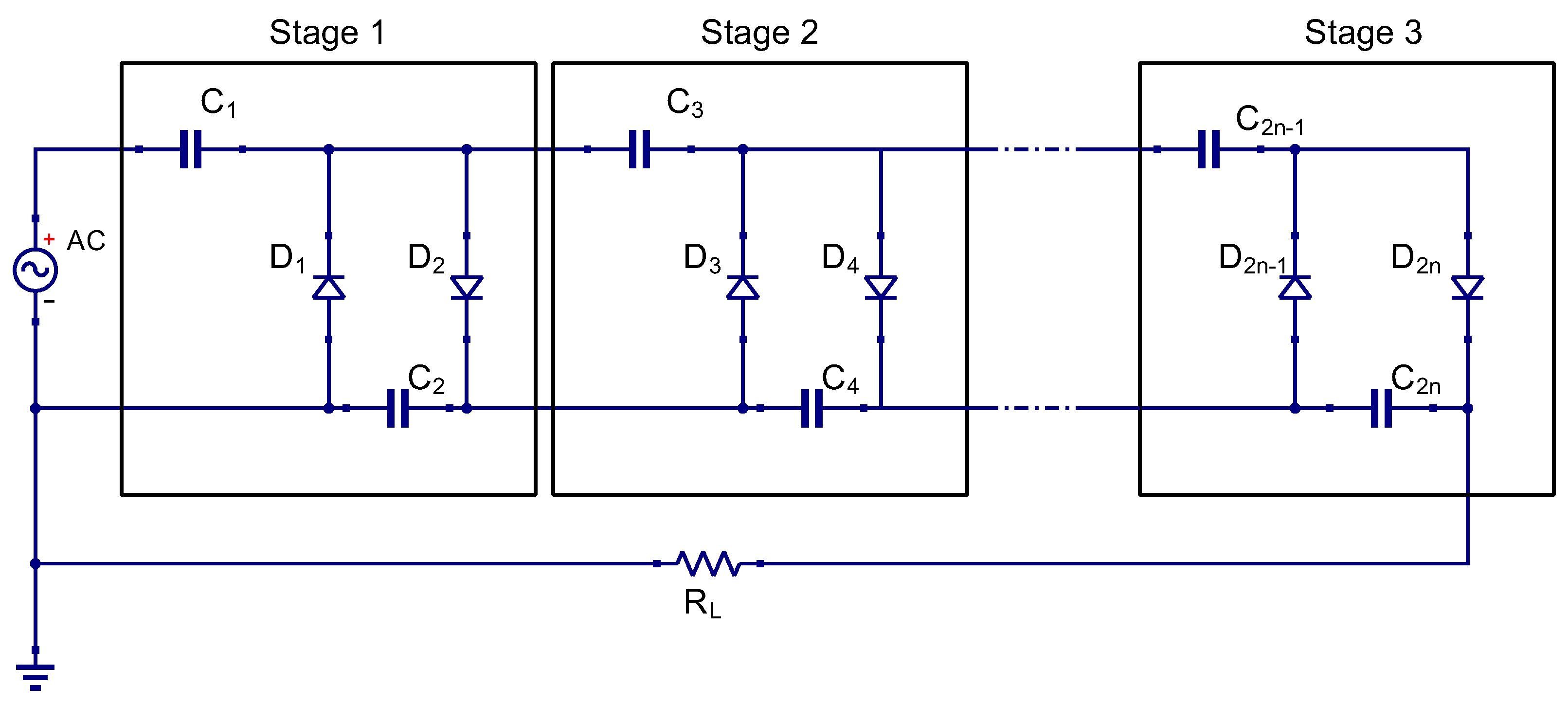
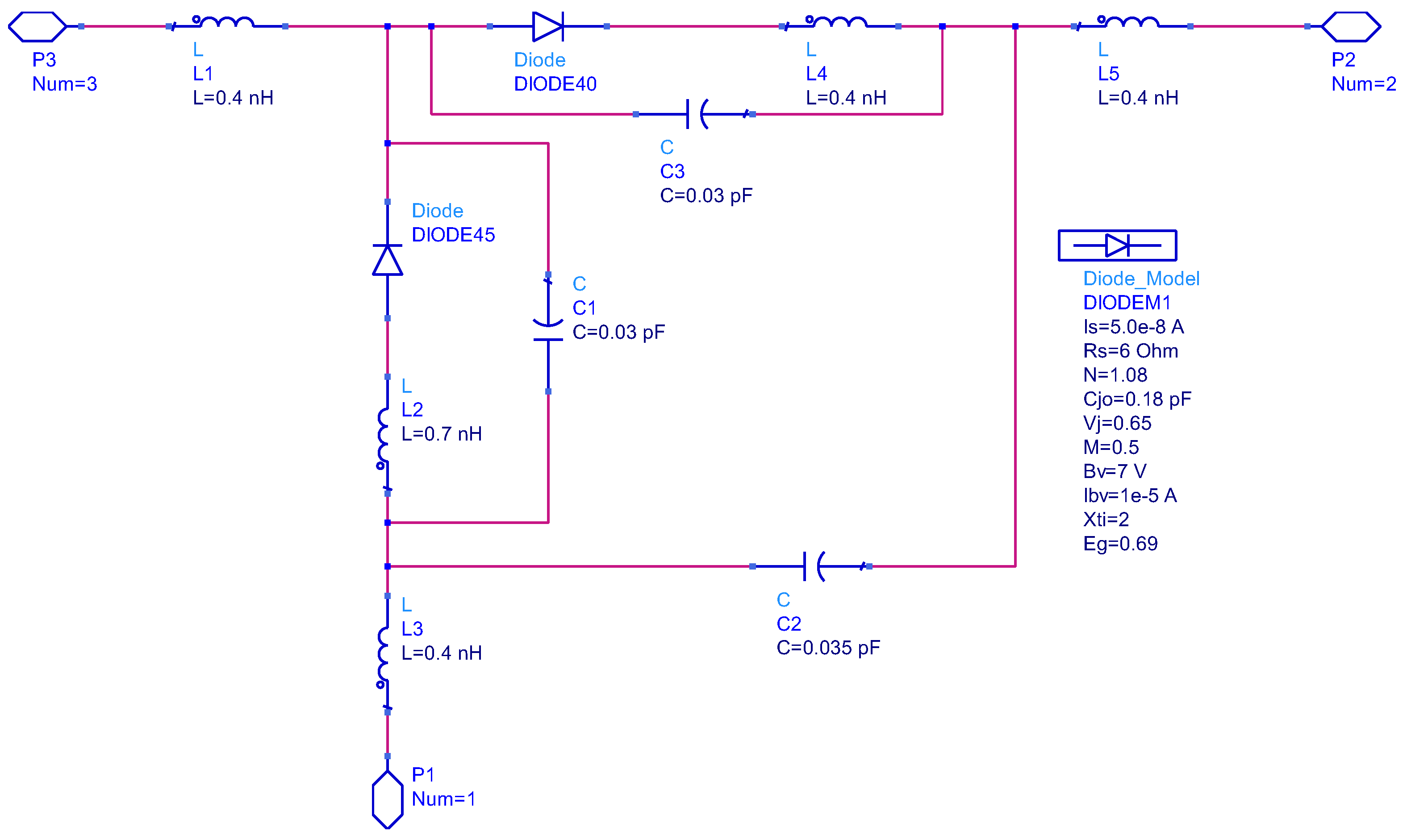


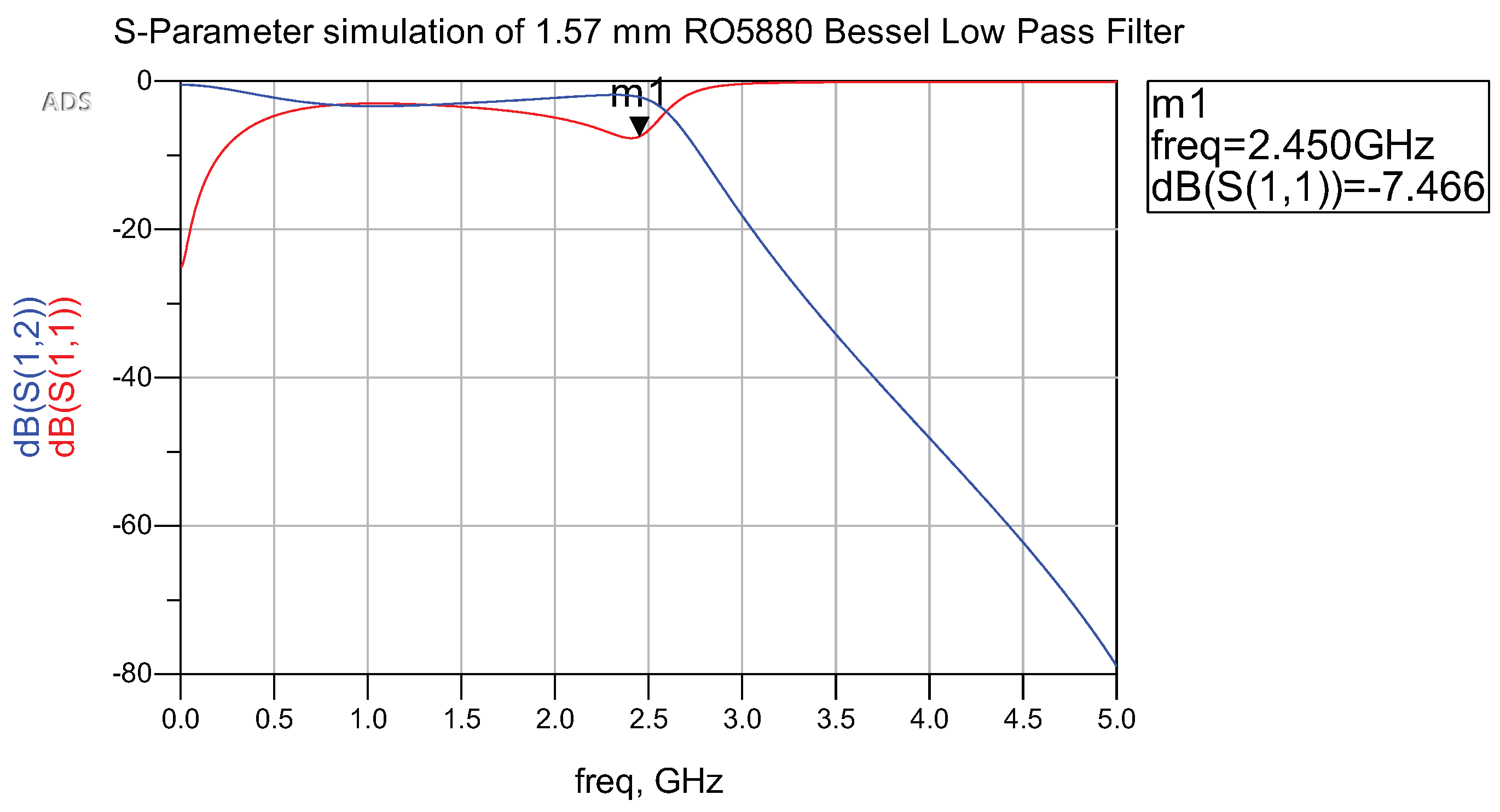


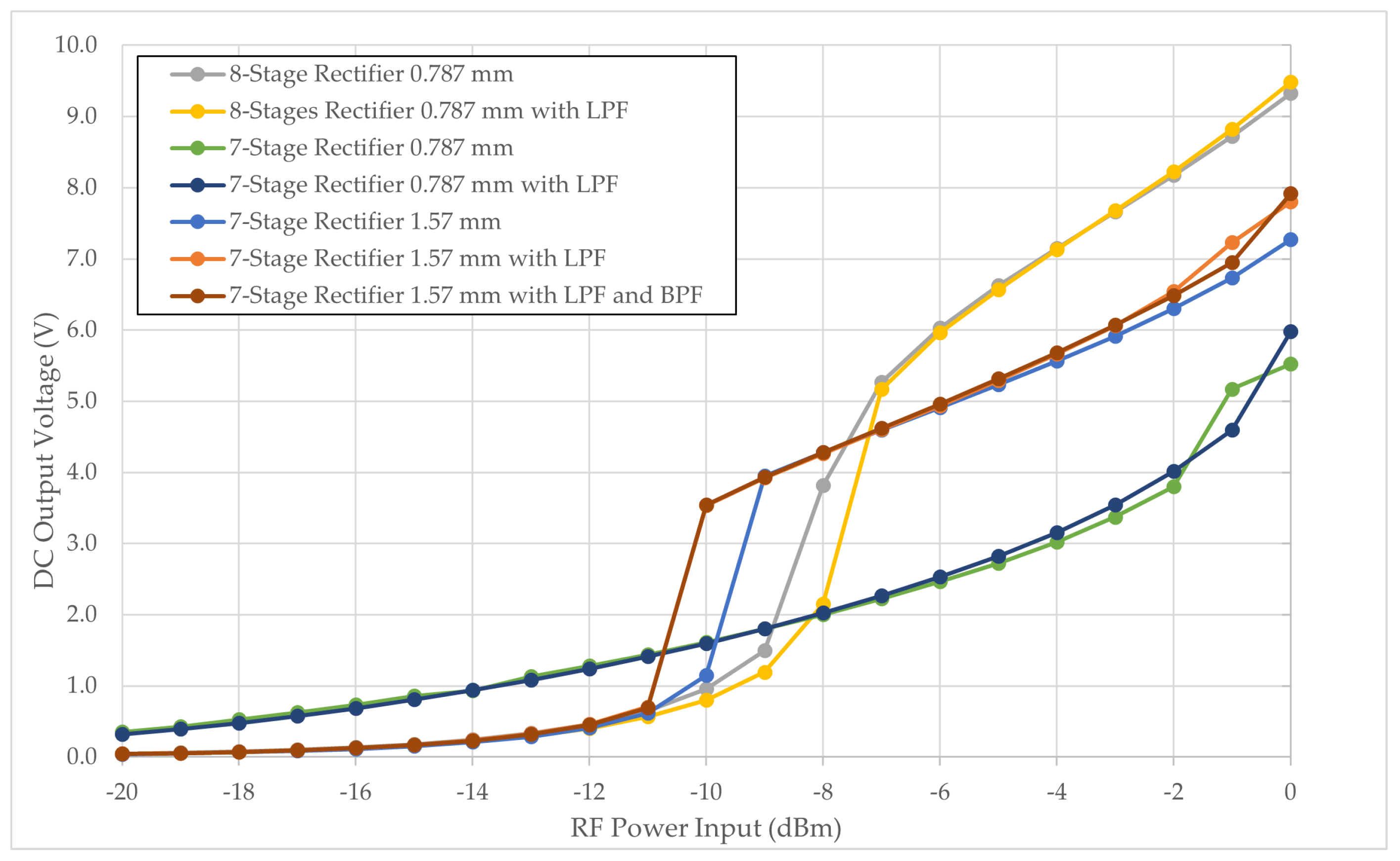
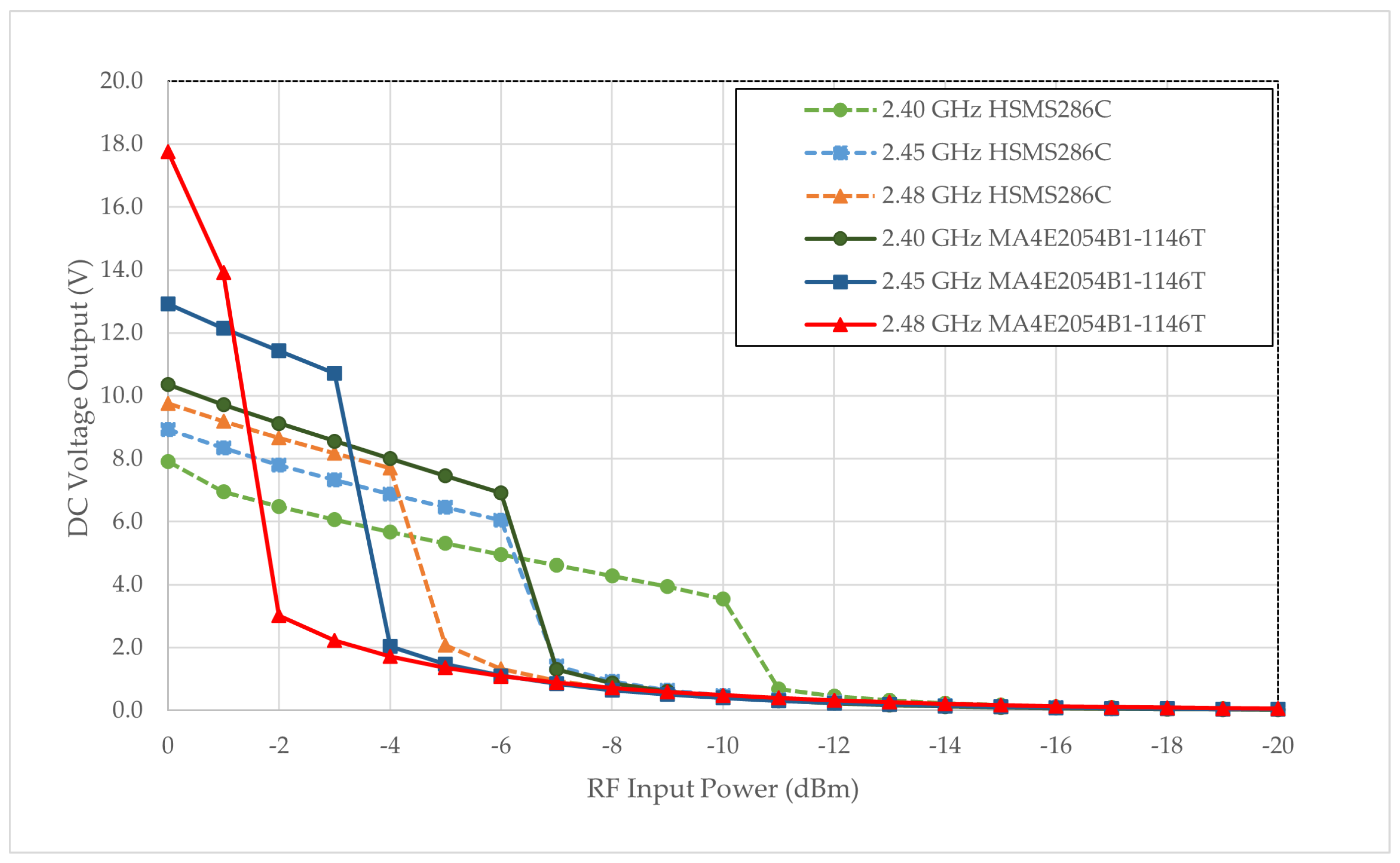
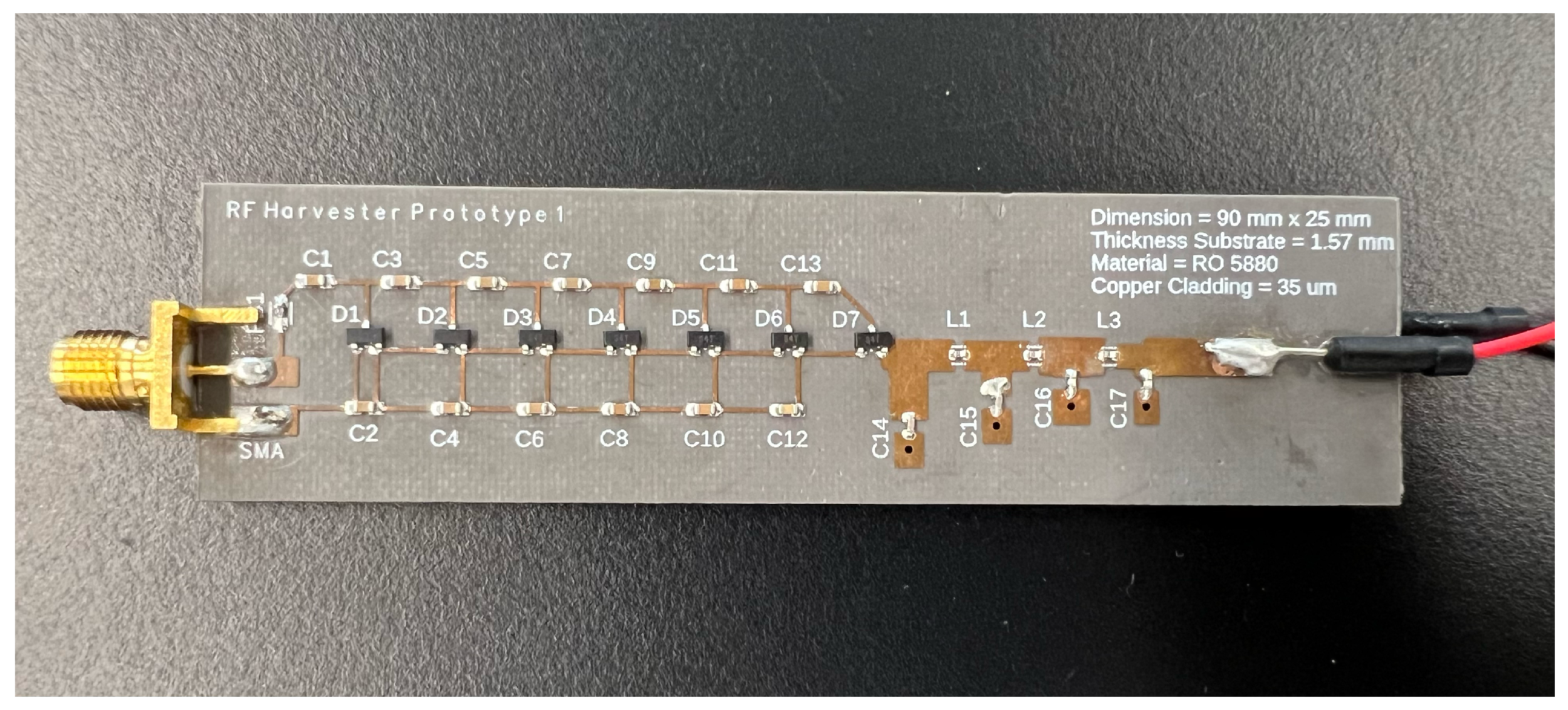

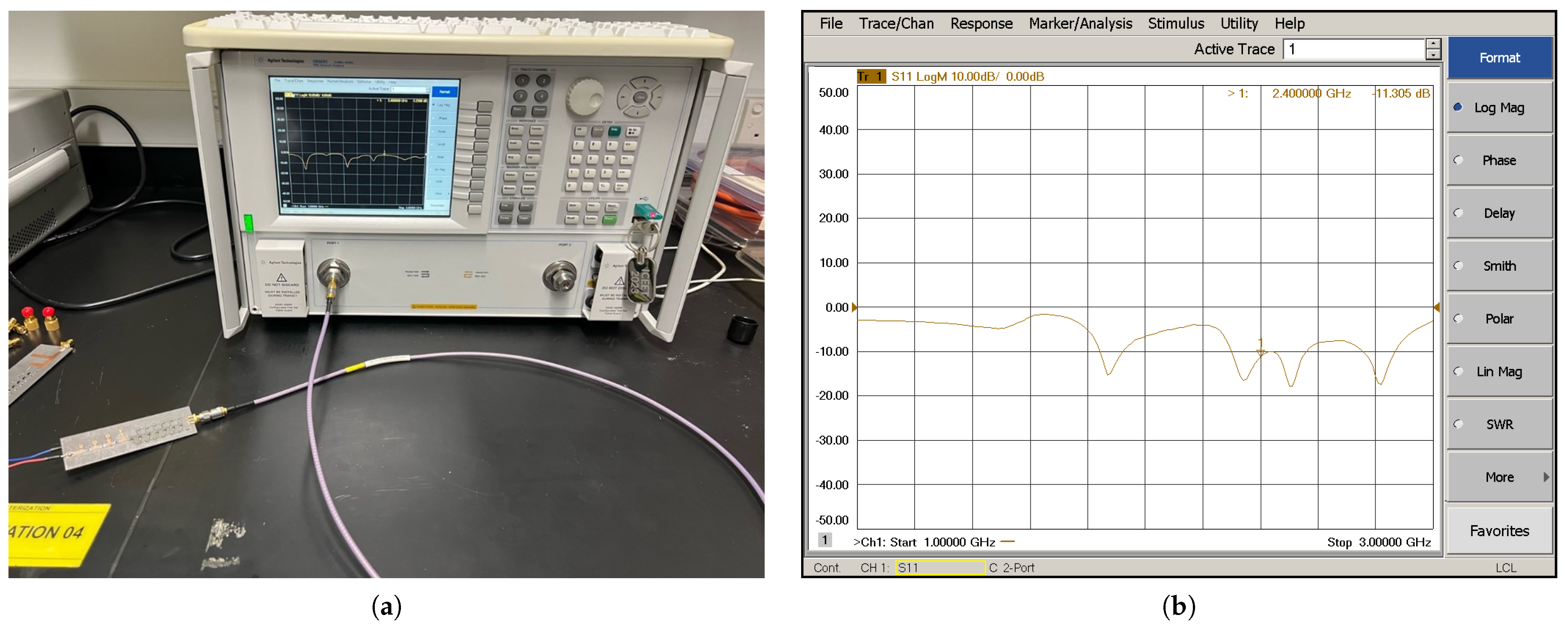
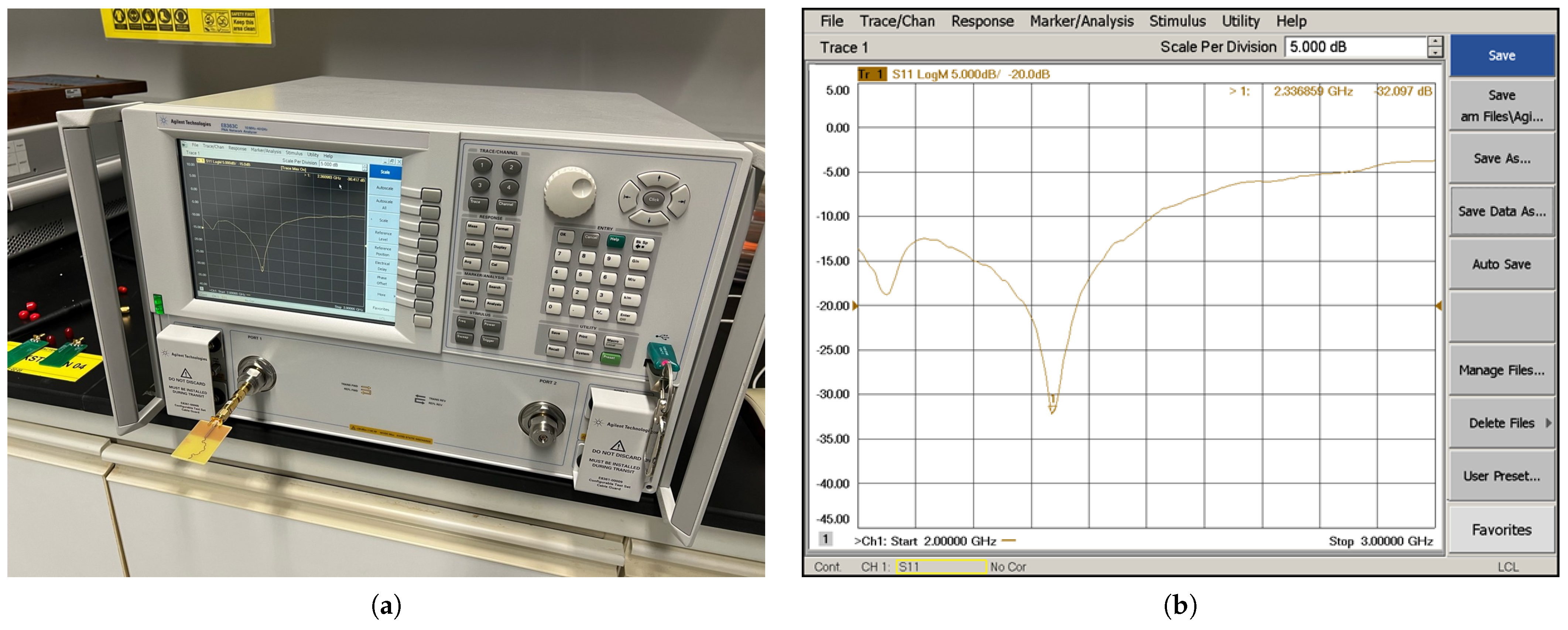

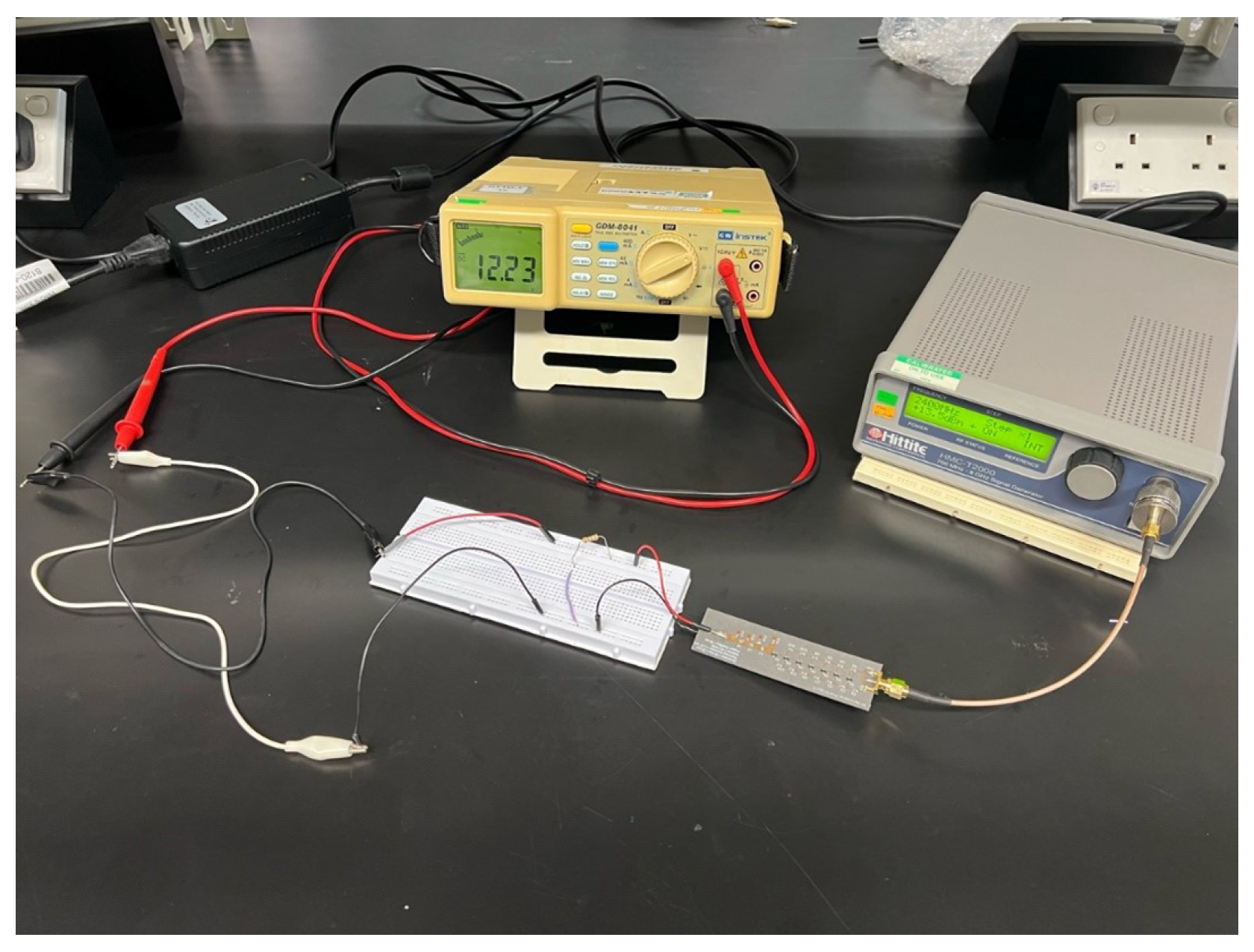
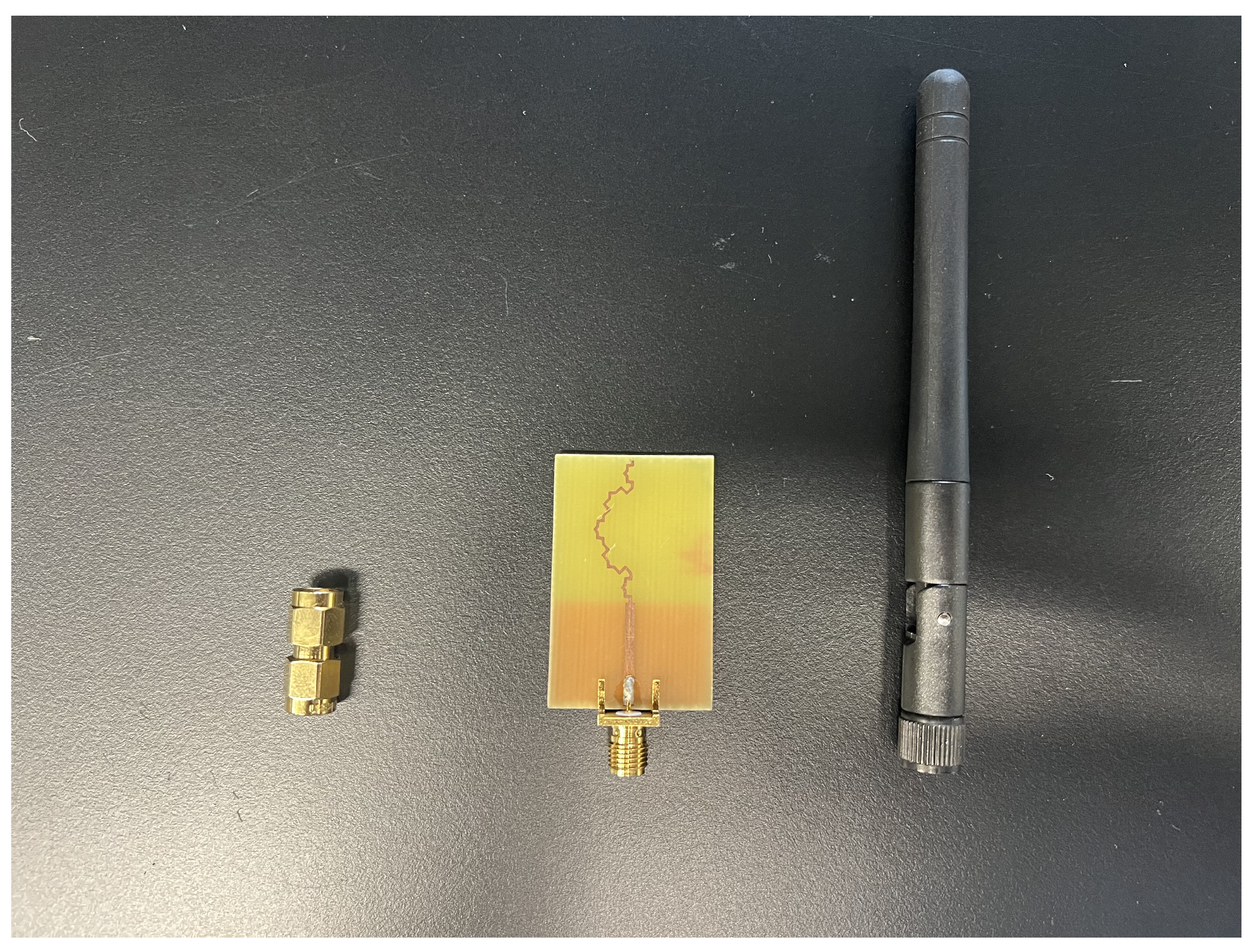
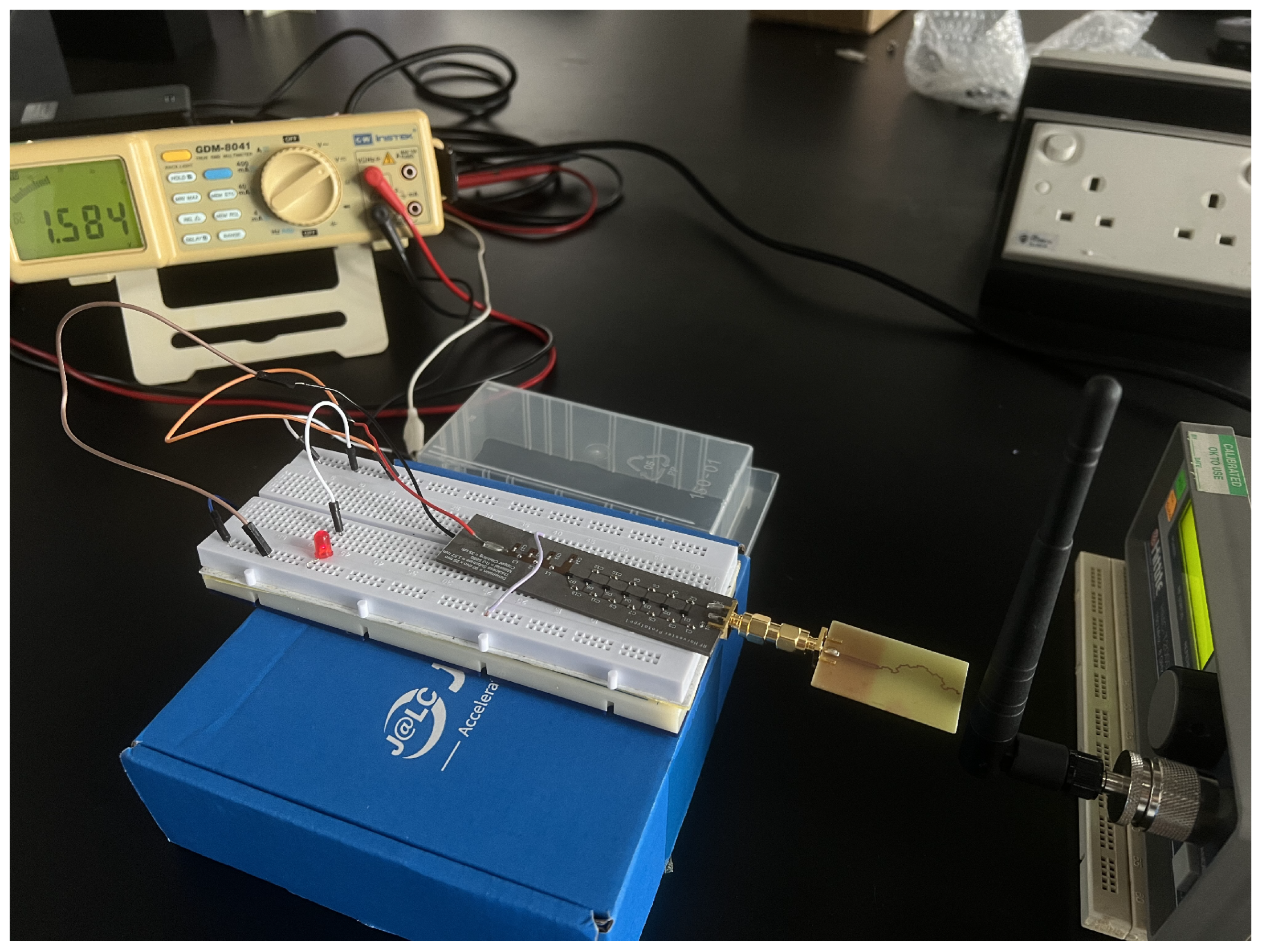
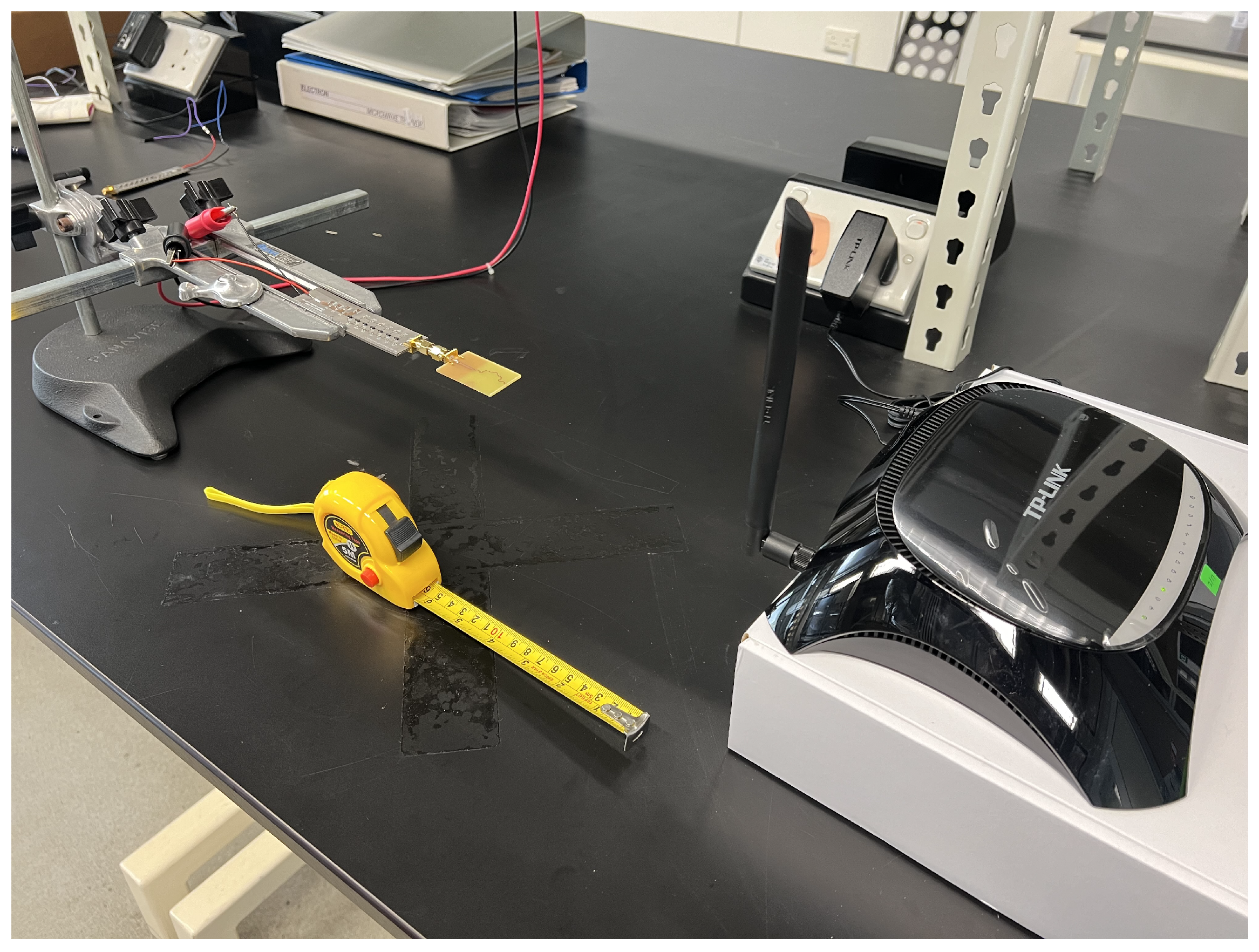
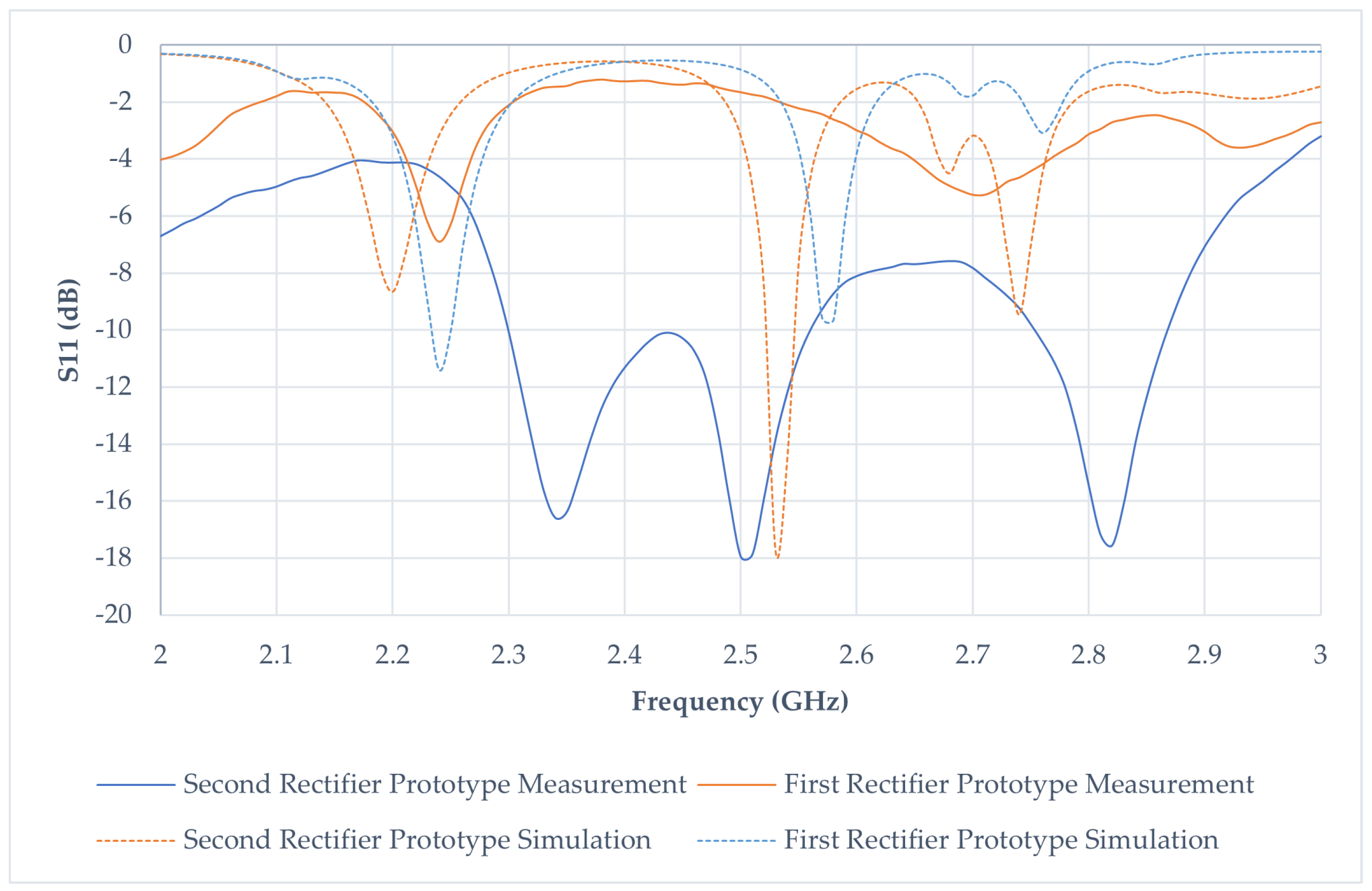

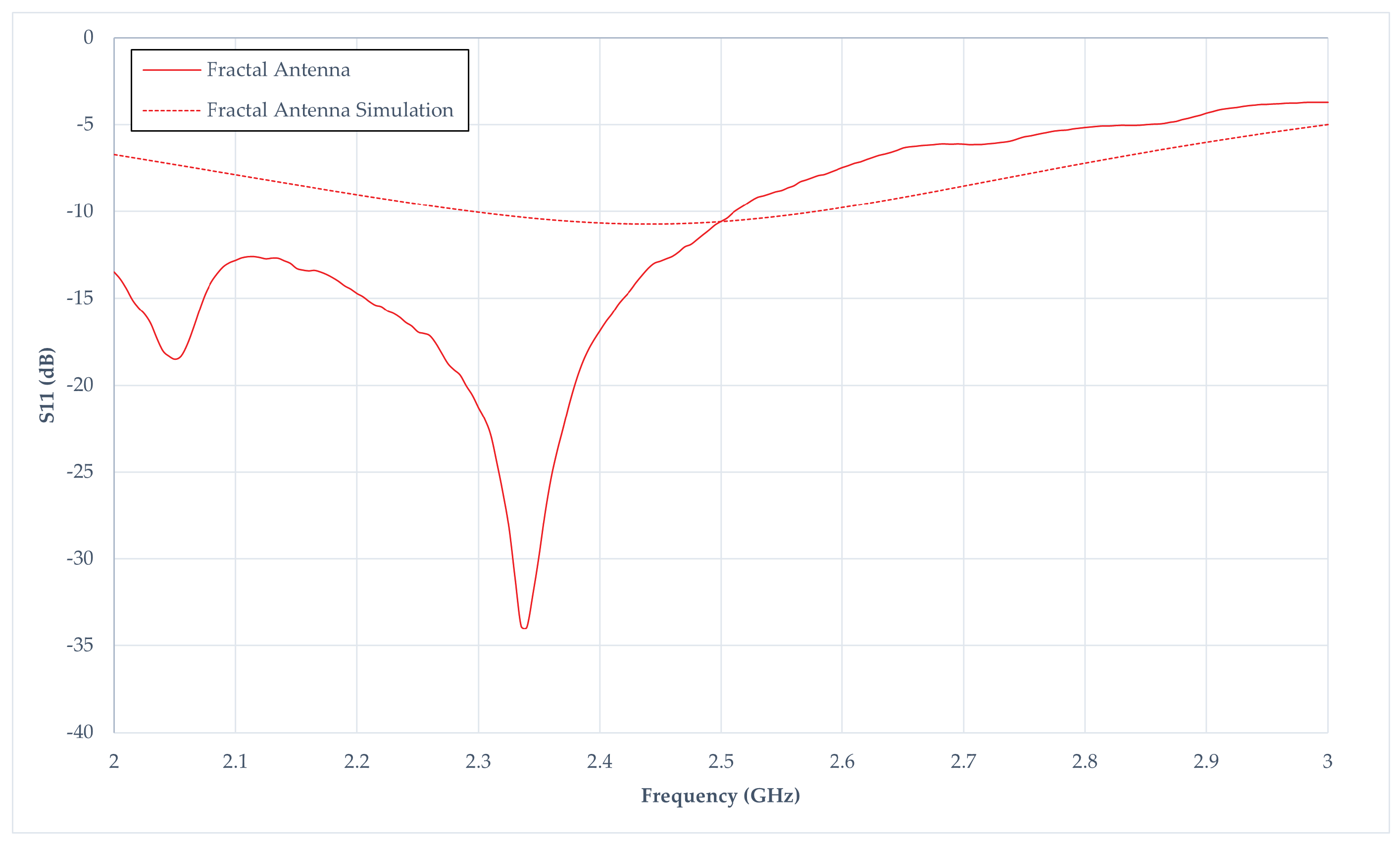
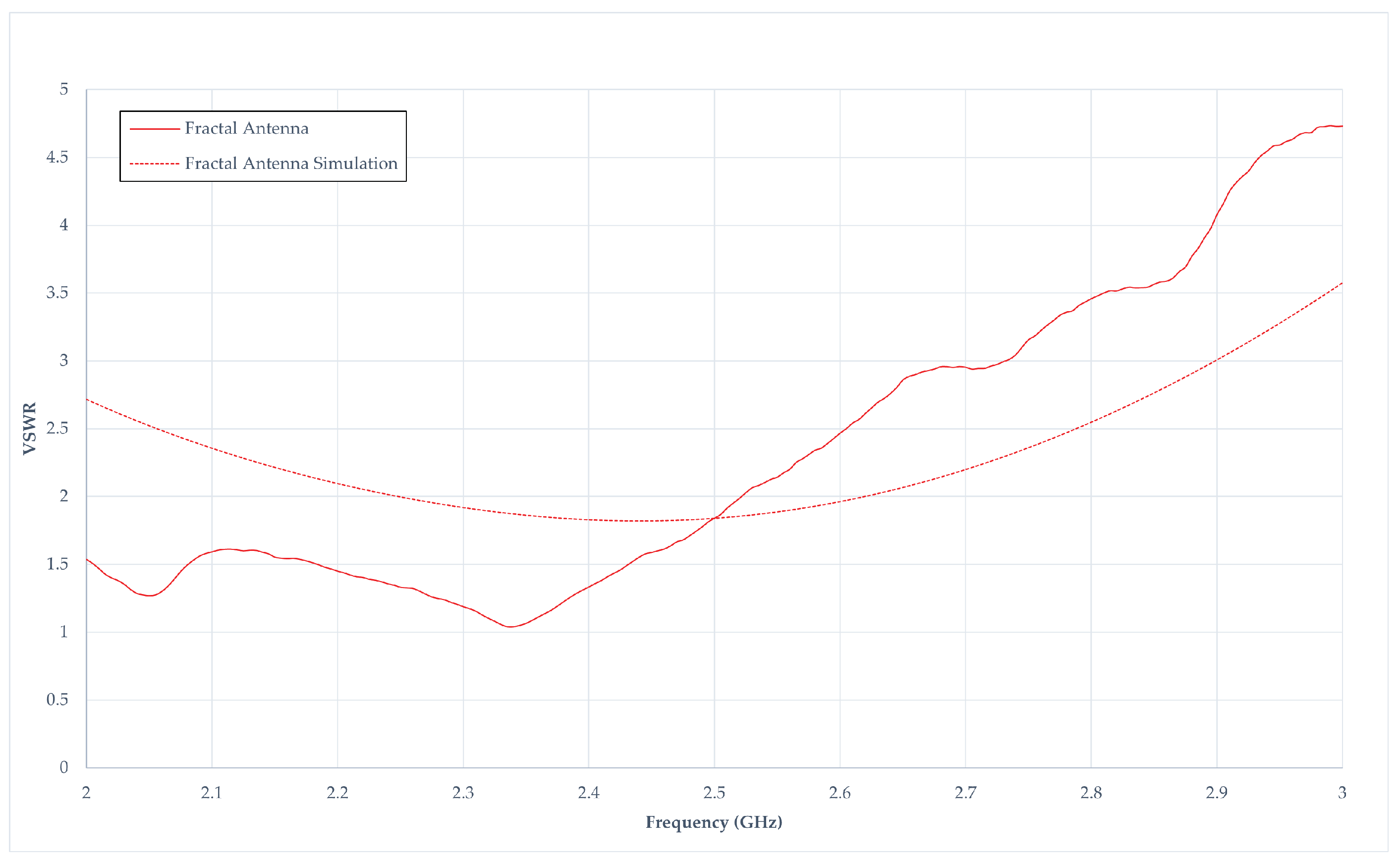


| Parameter | Description | Units | HSMS 2820 | HSMS 2850 | HSMS 2860 | HSMS 286C | MA4E2054B1 1146T |
|---|---|---|---|---|---|---|---|
| Cj | Junction Capacitance | pF | 0.7 | 0.18 | 0.18 | 0.18 | 0.13 |
| Rs | Series Resistance | Ω | 6 | 2.5 | 5 | 6 | 11 |
| Ref. | Substrate | Dielectric Thickness (mm) | Center Freq. (GHz) | Pin (mW) | R load (kOhm) | Vout (V) |
|---|---|---|---|---|---|---|
| [13] | RO5880 | 1.57 | 2.48 | 0.13 | 1000 | 2 |
| [14] | RO5880 | 0.787 | 2.630 | 1.0 | 7.88 | 2.15 |
| [15] | FR4 | 0.787 | 0.925 | 1.0 | 5.00 | 1.54 |
| [16] | FR4 | 1.50 | 2.45 | 316 | 0.33 | 6.47 |
| Circuit Design | DC Voltage Output at 0 dBm (V) |
|---|---|
| 1-stage rectifier circuit (HSMS286C) | 2.2 |
| 1-stage rectifier circuit (MA4E2054B1-1146) | 2.23 |
| 7-stage rectifier circuit | 5.52 |
| 7-stage rectifier with LPF | 5.98 |
| 8-stage rectifier circuit | 9.32 |
| 8-stage rectifier circuit with LPF | 9.48 |
| Improved 7-stage rectifier circuit | 7.27 |
| Improved 7-stage rectifier circuit with LPF | 7.802 |
| Improved 7-stage rectifier with LPF and BPF | 7.913 |
| Improved 7-stage rectifier with LPF and BPF (MA4E2054B1-1146) | 10.36 |
| Improved 7-stage rectifier with LPF and BPF (FR4 and MA4E2054B1-1146T) | 6.40 |
| L | W | L M-K | W M-K | Lf | Wf |
|---|---|---|---|---|---|
| 40 | 25 | 23 | 0.66 | 16 | 1.8 |
| Rectifier Prototype 1 | Rectifier Prototype 2 | |
|---|---|---|
| VSWR | 13.59 | 1.57 |
| Reflected Power (%) | 74.46 | 4.92 |
| Forward Power (%) | 25.54 | 95.08 |
| Simulation | Fractal Antenna Prototype | |
|---|---|---|
| VSWR | 1.83 | 1.33 |
| Reflected Power (%) | 8.60 | 2.01 |
| Forward Power (%) | 91.40 | 97.99 |
| Antenna Distance (cm) | Fractal Antenna (dBm) |
|---|---|
| 0 | −4.06 |
| 5 | −24.28 |
| 10 | −21.38 |
| 15 | −21.05 |
| 20 | −17.56 |
| 25 | −20.99 |
| 30 | −21.56 |
| Prototype 1 | Prototype 2 | |||||
|---|---|---|---|---|---|---|
| Power Input (dBm) | Free Load (V) | 1 M Load (V) | Red LED Load (V) | Free Load (V) | 1 M Load (V) | Red LED Load (V) |
| 21 | 23.61 | 23.19 | 1.96 | 33.91 | 32.66 | 1.71 |
| 20 | 22.39 | 21.81 | 1.94 | 32.75 | 31.53 | 1.70 |
| 19 | 20.76 | 20.04 | 1.92 | 31.86 | 30.87 | 1.69 |
| 18 | 18.15 | 17.51 | 1.90 | 31.16 | 30.01 | 1.69 |
| 17 | 16.24 | 15.71 | 1.89 | 30.29 | 28.45 | 1.68 |
| 16 | 14.48 | 14.02 | 1.87 | 28.38 | 26.04 | 1.67 |
| 15 | 13.10 | 12.71 | 1.85 | 26.37 | 23.94 | 1.66 |
| 14 | 11.70 | 11.31 | 1.83 | 24.51 | 22.09 | 1.65 |
| 13 | 9.95 | 9.53 | 1.81 | 23.16 | 19.88 | 1.64 |
| 12 | 8.68 | 8.23 | 1.80 | 19.14 | 17.12 | 1.63 |
| 11 | 7.63 | 7.15 | 1.78 | 16.22 | 14.45 | 1.62 |
| 10 | 6.70 | 6.21 | 1.76 | 13.71 | 12.16 | 1.61 |
| 9 | 5.75 | 5.24 | 1.74 | 11.27 | 9.95 | 1.59 |
| 8 | 5.29 | 4.79 | 1.73 | 10.18 | 8.96 | 1.58 |
| 7 | 4.33 | 3.824 | 1.70 | 7.93 | 6.98 | 1.55 |
| 6 | 3.79 | 3.264 | 1.67 | 6.77 | 5.87 | 1.52 |
| 5 | 3.25 | 2.723 | 1.63 | 5.68 | 4.82 | 1.48 |
| 4 | 2.76 | 2.233 | 1.58 | 4.74 | 3.95 | 1.43 |
| 3 | 2.35 | 1.846 | 1.52 | 4.01 | 3.29 | 1.37 |
| 2 | 2.01 | 1.515 | 1.47 | 3.44 | 2.75 | 1.31 |
| 1 | 1.84 | 1.345 | 1.43 | 3.13 | 2.45 | 1.28 |
| 0 | 1.54 | 1.065 | 1.37 | 2.63 | 2.01 | 1.20 |
| −1 | 1.31 | 0.848 | 1.28 | 2.23 | 1.64 | 1.07 |
| −2 | 1.11 | 0.670 | 1.13 | 1.90 | 1.33 | 0.90 |
| −3 | 0.89 | 0.482 | 0.92 | 1.55 | 1.02 | 0.73 |
| −4 | 0.75 | 0.376 | 0.76 | 1.30 | 0.80 | 0.59 |
| −5 | 0.62 | 0.285 | 0.64 | 1.11 | 0.64 | 0.50 |
| −6 | 0.53 | 0.216 | 0.54 | 0.93 | 0.50 | 0.43 |
| −7 | 0.43 | 0.155 | 0.44 | 0.78 | 0.39 | 0.39 |
| −8 | 0.40 | 0.114 | 0.38 | 0.66 | 0.29 | 0.40 |
| −9 | 0.38 | 0.087 | 0.38 | 0.57 | 0.22 | 0.38 |
| −10 | 0.37 | 0.066 | 0.38 | 0.39 | 0.17 | 0.39 |
| −11 | 0.39 | 0.066 | 0.38 | 0.39 | 0.17 | 0.39 |
| −12 | 0.38 | 0.066 | 0.38 | 0.38 | 0.17 | 0.38 |
| −13 | 0.38 | 0.066 | 0.38 | 0.38 | 0.17 | 0.38 |
| −14 | 0.38 | 0.066 | 0.38 | 0.38 | 0.17 | 0.38 |
| −15 | 0.38 | 0.066 | 0.38 | 0.38 | 0.17 | 0.38 |
| −16 | 0.38 | 0.066 | 0.38 | 0.38 | 0.17 | 0.38 |
| −17 | 0.38 | 0.066 | 0.38 | 0.38 | 0.17 | 0.38 |
| −18 | 0.38 | 0.066 | 0.38 | 0.37 | 0.17 | 0.38 |
| −19 | 0.38 | 0.066 | 0.38 | 0.37 | 0.17 | 0.38 |
| −20 | 0.38 | 0.066 | 0.38 | 0.37 | 0.17 | 0.38 |
| Rectenna Combination | Antenna Distance for Red LED to Light Up (mm) |
|---|---|
| Prototype 1 | 11 |
| Prototype 2 | 15 |
| Distance between Antenna (cm) | Fractal Antenna with Prototype 1 | Fractal Antenna with Prototype 2 |
|---|---|---|
| 0 | 5.710 | 18.12 |
| 1 | 1.731 | 7.79 |
| 2 | 0.672 | 3.312 |
| 3 | 0.390 | 1.184 |
| 4 | 0.356 | 0.410 |
| 5 | 0.276 | 0.393 |
| 6 | 0.225 | 0.374 |
| 7 | 0.187 | 0.369 |
| 8 | 0.176 | 0.364 |
| 9 | 0.158 | 0.348 |
| 10 | 0.151 | 0.323 |
| 11 | 0.130 | 0.381 |
| 12 | 0.080 | 0.418 |
| 13 | 0.070 | 0.396 |
| 14 | 0.054 | 0.389 |
| 15 | 0.052 | 0.388 |
| 16 | 0.050 | 0.369 |
| 17 | 0.040 | 0.357 |
| 18 | 0.032 | 0.370 |
| 19 | 0.021 | 0.375 |
| 20 | 0.020 | 0.365 |
| 21 | 0.025 | 0.234 |
| 22 | 0.040 | 0.188 |
| 23 | 0.060 | 0.144 |
| 24 | 0.060 | 0.180 |
| 25 | 0.035 | 0.390 |
| 26 | 0.021 | 0.395 |
| 27 | 0.016 | 0.325 |
| 28 | 0.018 | 0.193 |
| 29 | 0.026 | 0.115 |
| 30 | 0.030 | 0.054 |
| Rectenna Combination | DC Voltage Output (mV) |
|---|---|
| Prototype 1 | 2.9 |
| Prototype 2 | 3.5 |
| Aspect | Current Work | Reference [36] | Reference [13] | Reference [37] | Reference [9] |
|---|---|---|---|---|---|
| Ultimate aim | Evaluating the integration of fractal antenna and RF energy harvester through simulation and experiment | Investigating the rectenna architecture for RFID through qualitative assesment | Examining the rectenna architecture with different multiplier topologies | Evaluating different antenna structures between monopole and fractal antenna | Evaluating different rectifier design for RF power energy harvester. |
| Measured output | 3.53 V at −10 dBm input, scalable efficiency improvements | 2 V with 2.4 GHz at −9 dBm input signal | 2 V with 2.4 GHz at −4 dBm input signal. | Varied outputs based on design with maximum of 0.097 V | 2 V output voltage at −9 dBm |
| Rectifier configuration | 7-stage rectifier with 1.57 mm RO5880 substrate and MA4E2054B1-1146T Schottky diode compared with HSMS286C diode | 7-stage rectifier with 1.57 mm RO5880 substrate | 7-stage rectifier with 1.57 mm RO5880 substrate | 7-stage rectifier with 1.57 mm RO5880 substrate | 7-stage rectifier with 1.57 mm RO5880 substrate with HSMS286C diode |
| Novelties | Integration of harmonic balance and rectenna design with the introduction of MA4E2054B1-1146T Schottky diode | Utilization of ambient Wi-Fi for power | Optimization for RFID specific settings | Focused on maximizing efficiency | Comprehensive system design with different substrate |
Disclaimer/Publisher’s Note: The statements, opinions and data contained in all publications are solely those of the individual author(s) and contributor(s) and not of MDPI and/or the editor(s). MDPI and/or the editor(s) disclaim responsibility for any injury to people or property resulting from any ideas, methods, instructions or products referred to in the content. |
© 2024 by the authors. Licensee MDPI, Basel, Switzerland. This article is an open access article distributed under the terms and conditions of the Creative Commons Attribution (CC BY) license (https://creativecommons.org/licenses/by/4.0/).
Share and Cite
Md Jamil, M.N.B.; Omar, M.; Ibrahim, R.; Bingi, K.; Faqih, M. Rectenna System Development Using Harmonic Balance and S-Parameters for an RF Energy Harvester. Sensors 2024, 24, 2843. https://doi.org/10.3390/s24092843
Md Jamil MNB, Omar M, Ibrahim R, Bingi K, Faqih M. Rectenna System Development Using Harmonic Balance and S-Parameters for an RF Energy Harvester. Sensors. 2024; 24(9):2843. https://doi.org/10.3390/s24092843
Chicago/Turabian StyleMd Jamil, Muhamad Nurarif Bin, Madiah Omar, Rosdiazli Ibrahim, Kishore Bingi, and Mochammad Faqih. 2024. "Rectenna System Development Using Harmonic Balance and S-Parameters for an RF Energy Harvester" Sensors 24, no. 9: 2843. https://doi.org/10.3390/s24092843
APA StyleMd Jamil, M. N. B., Omar, M., Ibrahim, R., Bingi, K., & Faqih, M. (2024). Rectenna System Development Using Harmonic Balance and S-Parameters for an RF Energy Harvester. Sensors, 24(9), 2843. https://doi.org/10.3390/s24092843







